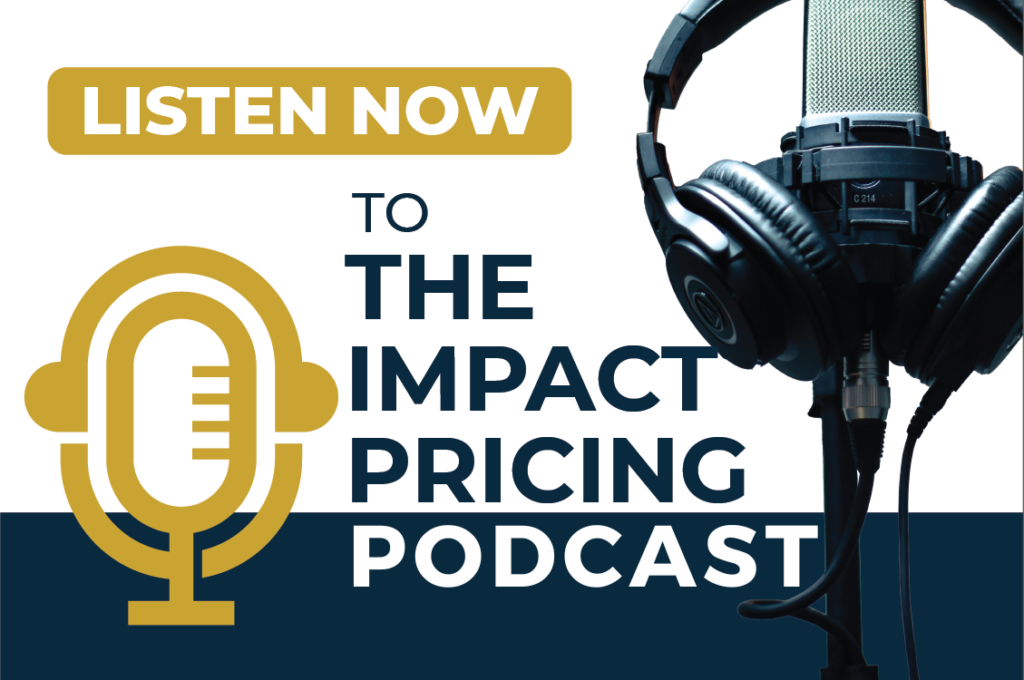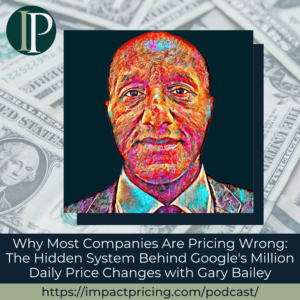
In this episode, Michael shares how the ROI calculator provides value conversation letting the buyer think of a financial number rather than just an admin tool.
Podcast: Play in new window | Download
Why you have to check out today’s podcast:
- Find out how ROI calculators provide value conversation between the buyer and seller
- Learn how ROI calculators allow a step-by-step process of building credibility and confidence to you, thereby holding firm on your pricing
- Discover how you can provide a collaborative approach between buyer and seller so they find, understand, and see the value and not ask for a discount
“Quantifying that value upfront. I mean, if you go in and they agree to the value you can bring them in the main areas where they’re looking, it is going to be impossible for them to come back and say, ‘Oh, yeah, we need a 40% reduction,’ especially if the return is ten times the investment.”
– Michael Farber
Topics Covered:
01:41 – How the ROI calculator changed the way he sold
04:20 – His thoughts on replacing the word ROI calculator with the word business case
05:51 – What’s the use of the ROI calculator?
07:15 – Using an ROI calculator template based on the vertical you’re working with
07:51 – What the process looks like for a salesperson letting the buyer fill out the ROI calculator
10:55 – A collaborative approach to using ROI calculator
12:30 – What it means to have the step-by-step process of using ROI calculator
17:16 – ‘Will I’ type questions can be built inside ROI calculator
18:17 – Building a security value calculator
20:05 – Michael’s best pricing advice that greatly impacts a business
Key Takeaways:
“Rationally, companies buy for two reasons: you’re going to make some money, you’re saving money, that’s really it at the end of the day. So, it’s even more important to do it. When a company sits down, or the rep sits down and does a good job of walking their prospect through it, it separates them from the other sellers, the other sellers aren’t doing it.” – Michael Farber
“You think about our interactive value calculator. It’s like its own website portal. So, we stir emotion with visuals, and videos and stories.” – Michael Farber
“Understanding the ‘Will I’ type questions, we could build those into the calculator. As I said, what we build is more than just how many employees do you have? What is their average salary? How many hours does it take, type thing? We build interactive discovery questions in it. So based on a certain answer or a drop-down, we can drive another discovery question. And then based on that discovery question, we can start to quantify a different area.” – Michael Farber
“I will tell you; I have not discounted our price in our last seven deals, not one penny, and we more than doubled our price since a year ago. So, it really does; they got to see the value. And then it’s hard for them to ask for a discount.” – Michael Farber
People/Resources Mentioned:
- Concur Technologies: https://www.concur.com/
- Bacardi: https://www.bacardi.com/
Connect with Michael Farber:
- Website: https://www.theroishop.com/
- LinkedIn: https://www.linkedin.com/in/michael-farber-9946281/
Connect with Mark Stiving:
- LinkedIn: https://www.linkedin.com/in/stiving/
- Email: [email protected]
Full Interview Transcript
(Note: This transcript was created with an AI transcription service. Please forgive any transcription or grammatical errors. We probably sounded better in real life.)
Michael Farber
Quantifying that value upfront. I mean, if you go in and they agree to the value you can bring them in the main areas where they’re looking, it is going to be impossible for them to come back and say, ‘Oh, yeah, we need a 40% reduction,’ especially if the return is ten times the investment.
[Intro]
Mark Stiving
Welcome to Impact Pricing, the podcast where we discuss pricing, value, and the calculated relationship between them. I’m Mark Stiving; today, our guest is Michael Farber. And here are three things you want to know about Mike before we start. He came highly recommended to me by a colleague, Mike Wilkinson. He’s been in sales since the early 2000s. He is the founder of The ROI Shop. And okay, so this is for, sorry, he started The ROI Shop without funding without a paycheck for three years and while paying for a wedding. Wow! Welcome, Mike.
Michael Farber
Hey, how’s it going, Mark? Thanks for having me.
Mark Stiving
I’m actually doing great today, but I’m really excited to talk to you because I often say things about ROI calculators that you probably don’t agree with. And so, I just would love to get this out on the table and have a conversation and learn more about how to think about them and how they make a ton of sense. So let me start with the easy question. How did you, I normally ask, how did you get into pricing? But you’re really not? How did you get into this whole concept of ROI calculators?
Michael Farber
Well, it actually happened during my time at Concur Technologies. It was about my second year there; they had their annual SKO. It was the second day of the annual meeting. And if everybody knows, the second day is the worst, throw up anything boring at eight in the morning. And that’s exactly what they did. They threw up an Excel spreadsheet. And half the crowd was hung over because they got to see their friends, you know, after a year. Anyway, they went through this Excel spreadsheet after the first two tabs; everybody tuned out. And that was the end of that. About a month after SKO, I worked with Bacardi USA; it was a very big account for me. I was in the National Space. But this was, you know, right below enterprise level. So, it was a very, very big deal for me. And I was working with their comptroller, his name was Warren, and he goes, Mike, I want to move forward with you. But we’re going to need a business case. And I said, ‘Oh, shoot Warren, no problem. We have one of those. I’ll fly down a little early. We’ll spend the morning we’ll build it together prior to the demo.’ He’s like, ‘All right, great.’ So, it took me about three days to locate it. After sending out a mass of emails, I finally got it. And it probably took me about another four or five days meddling with it just so I felt comfortable with it. So, when I flew down to Bacardi, we sat down, we muddled through it together. And then, at the end of the session, he goes, ‘Mike, I got to tell you, this is one of the better tools I’ve seen.’ So, I thought to myself, alright, I’m no schmuck here, maybe I got a competitive advantage. I didn’t like doing it. It wasn’t fun for me; I would never have done it unless he asked. So really, this guy changed my life. Following that meeting, I started utilizing it and every opportunity. So after about four times, it completely changed the way I sold. And I’m like, wow, this is a really, really valuable tool. I shortly left Concur, afterward, went to a new company, they didn’t have an ROI calculator, my best friend was going to build one, you know, because he was a whiz in Excel, I went to the VP of sales and said, ‘Hey, can we build something like this as what I’m used to?’ He goes, ‘Yeah, sure, how much?’ And he was going to do it for free. I got my friend $3,000. But then it really got me thinking about, God, you got all these companies making 100 million in ARR and even more, they do not have a great way of talking about value. So that’s really how it all started; I was forced to use it on one deal. And it changed the way I sold, and I realized there was a huge void in the marketplace.
Mark Stiving
Okay, so I absolutely love that story, by the way. And I think it almost sounds like I could replace the word ROI calculator with the word business case. Would you agree with that or not agree with that?
Michael Farber
Yeah, I would say that, and I’m actually changing the name myself because I hate the word ROI calculator; just like you said, you have negative feelings, perhaps or ideas about it. And I think they’re probably all right because ROI was done so terribly for so long that I like to call it a value calculator. Because what we’ve created is much more than something you just plug in numbers, and it spits out a number. You know, there are discovery questions that automatically appear based on numbers or an output or things to ask a deeper question. So, I do hate the term ROI calculator myself because you get that pit in your stomach.
Mark Stiving
Oh man, if you said the word value calculator to me earlier, I would have gotten even more excited.
Michael Farber
Now you calculate everything I say.
Mark Stiving
Nice, nice. So, let’s talk about the use of an ROI calculator. Let’s call it a value calculator. I’ll feel even better. Let’s talk about the use of a value calculator for a second. I have lots and lots of thoughts or questions about it. But to begin with, different customers get value from different things. So, let’s say that I have a problem selling a single product, just to make life easy. And I could probably find 10, or 15, or 20 different places, a customer of mine could make money, or get value from my product. Is the idea to list all of these to find the one or two that matter to each individual customer to find the top three and just use those for everybody? How do you think about this?
Michael Farber
Great question, Mark. And it’s something I always talk to, with my prospects because the key is that it has to be simple to use, not only for your salesperson but your champion, because they’re the ones who have to go back and use it. So, what I always suggest is don’t try to boil the ocean and figure out all 15 areas that you can make or save your prospect money. Think about the low-hanging fruit, four or five, you know, the 80/20 rule. What do most of your prospects gravitate to and build those into a kickass job with those? Because of the 8, 9, 10, 11 other use cases, they’re not going to, that’s not going to be why they buy your solution. There are probably three or four main reasons, and the other ones are nice to have. So, I always suggest you’re better off doing a kickass job on three or four than an okay job on eight.
Mark Stiving
Do you think it matters? I don’t even know how to ask this question. It feels like I could have the same ROI situation with two different companies that measure it differently and think about it differently. And so, if I have a single calculator, I’m not using their language. I’m using my language. Did I do that question justice?
Michael Farber
I’m not exactly sure I follow you. Are you trying to say if you’re selling to two different types of verticals or industries, and their language is different?
Mark Stiving
Sure, we could we could put it that way.
Michael Farber
Yeah, that might mean two separate calculators. I’m not saying we’re boiling it down, and you have one calculator you’re using for every opportunity; you might have two or three or four different templates, if you will, one for you know FinTech, healthcare, you know, manufacturing. So, you can select which template you’d want based on the vertical you’re working with.
Mark Stiving
So, walk me through the approach you expect, or you would help a salesperson do when they’re trying to get a potential buyer to fill out the ROI calculator with them and assume it’s with them.
Michael Farber
Yes, it’s collaborative. And we have our own methodology on where and how to use it. When I first started the company, we built these calculators, gave them to them, and said have at it, which was an epic failure. Because one, salespeople hate to add anything in the sales process, you know, we’re stubborn, is all akin to change the game is something we’re not interested in. So, we really started thinking about how we could increase adoption and where the value calculator should be put in to the sales cycle. And the answer, like most things, was very, very obvious and easy. So, if you think about the black hole in the sales cycle, for 80% of B2B SaaS companies who do demonstrations, the black hole in the sales cycle happens after the demo. That’s where you start getting ghosted. You know, you’ve given you a demo, Mark, now, you’re going to go back and talk to other folks perhaps, and then we never hear from you again. So that happens more often than not. So, if you think about what happens with the buyer after a demo, it’s like, if you go to a car dealership, and you take a car for a test drive, you know, there’s not much else to do. And it’s very similar to that with a demo. So, if I give you a demo, the things that are going through your head after the demo are, can we afford it? Is it worth the time? Is it worth the investment? Is it worth the disruption? Is this even a priority? These are all financial thoughts? Because if the ROI is huge, then the answer to those questions is yes. So, what we suggest is you tag the ROI on to the end of a step everybody’s already doing, which is the demo. And we do it in small chunks. So, if I had a discovery call with you and one of your areas is reduced downtime, you know, maybe you’re a manufacturing company and reduce downtime, increased productivity, you know, those reduce inventory, maybe those are three value areas that we identified. At the end of the demo, I build out one section with you. ‘Mark, thanks so much for watching the demo. You said you were interested in reducing downtime. Let’s build out this one value bucket together.’ So, now you leave the demo thinking about a financial number rather than an admin tool or some obscure reporter. And then, we set up a follow-up call to build out the other two areas of interest. So, we’re actually helping you in the buying process. Most salespeople let go of the buyer’s hand after the demo, and many buyers don’t know how to buy. That was a long-winded answer. But hopefully that…
Mark Stiving
No, I think that was a great answer. What I usually try to help salespeople with, and I talk about a lot, is something called a value conversation. And when I think of a value conversation, I think it’s very similar to what you’re describing. Except my expectation isn’t that I’ve handed you a calculator or an Excel spreadsheet or a tool that says, here stick in their numbers, and out pops the return or the value of the dollar. Instead, it’s walking them through the calculations so that they can calculate the value themselves. And now they believe it more than if I told them, hey, you’re going to make a million dollars?
Michael Farber
Yeah, 95% of all salespeople say, ‘Oh, we can increase revenue 3x or increased productivity by 40%.’ What the hell does that even mean? These are just 1000 foot level ROI metrics you’re throwing against the wall, but it’s a collaborative approach when you build it with them. And then they feel confident enough to go back and sell it internally. They’re the ones that have to use it internally.
Mark Stiving
Let me try that again, though, because what I’m not talking about is, like, I’m in pricing. And in pricing systems, we usually say, look, as soon as you touch a pricing system, you’re going to probably make one to 5% of your revenue and additional profit, right, which is a huge number. And it’s like a no-brainer, but there’s no support or justification behind that number. But as soon as I take it down to a value calculator, I say, look, you are bidding against yourself when you make three different bids in three different channels to the same customer. And they are smartly choosing the lowest price bids you gave them. Because you bid against yourself, you’re giving up this much money; you do it this many times a year, here’s how much money you’re giving up. So, therefore, this is how much money you’re about to go make when you solve this problem. Now, the difference is, I don’t go in and say, ‘Look, you’re going to save one to 5%.’ It’s a look at how much money we can make or, better yet, it’s how many times do we do this? Let’s go through the data and look to see what actually happens here. And what does it cost you? And then if we do that, and the customer says, ‘Yeah, I get it.’ Now, it’s, that’s a million-dollar problem. They really believe it.
Michael Farber
Absolutely. Yeah. People aren’t necessarily good with Math. Most people aren’t good with math or numbers. But going through that step-by-step process, when they see that number, and they understand it. Then, absolutely, it’s like writing, then they see it, they say it out loud, it means something like a goal, I’m going to lose 10 pounds, it’s in my head. That’s easy enough, but they say write it down, look at it, read it. It means more psychologically. So going through the exercise, it’s the same type of thing.
Mark Stiving
Yeah, I write down that I got to lose 10 pounds, and I’ve gotten really good at ignoring it. So, it’s okay.
Advertisement
Pricing decisions feel risky. How nervous are you knowing you need to raise prices? When, where, and how much should you raise prices, so you don’t lose customers or lower your rate of new customer acquisition? It’s risky enough to make you want to put it off till next year, along with any growth. But pricing doesn’t have to be such a mystery. When I work with clients as their go-to resource for pricing advice, I help them better understand the value of their products, and how their buyers use price to make purchase decisions. We jointly create strategies they’re confident implementing; I can do the same for you. Together, you and I apply pricing frameworks to your price increase initiatives, or your new product launches, or even moving to new pricing models like subscriptions. The best pricing decision you can make right now is to gain access to proven pricing advice. Take some risk out of your pricing; learn more at impactpricing.com/advisor. I look forward to working with you.
Mark Stiving
Another big issue that I see with ROI calculators, value calculators, is a concept that I teach a lot called ‘will I’ and ‘which one’. And what this concept essentially means is that most buyers go through two different decision processes or decisions when they make a purchase. The first one is, am I going to buy something in the product category? And so, the value of that is what’s the value of solving the problem. Then if I say yes, I want to solve the problem. Now it’s okay; which one am I going to go by? And now it’s what’s the value of your solution relative to the competitive alternatives. So how do you think about that when you think about creating a value calculator?
Michael Farber
Well, the thing, why it’s even more important today is there’s typically, between eight and 12 people involved in a decision process today, and one of those people is going to have an ROI or value checkbox that you’re going to have to check. So, you know, you’re eliminating that you might be emotionally invested in the solution. But now you have to get the other eight, nine, or ten people emotionally invested in; they’re probably not going to be, they’re going to do it rationally. And rationally, companies buy for two reasons; you’re going to make some money, you’re saving money, that’s really it at the end of the day. So, it’s even more important to do it. But when a company sits down, or the rep sits down, and does a good job of walking their prospect through it, it separates them from the other sellers; the other sellers aren’t doing it; they seem buttoned up, they’re helping the champion more. And, you know, I know you’re into pricing; it’s going to allow them to hold firm on their pricing. So, when they go through this step, and they’ve uncovered all these areas of value, and you get them to buy into it at the end, it will be very difficult for them to say, oh, we want a 30% discount. So, it builds credibility for you. It also builds confidence as a salesperson. When you realize what you’re providing does provide value, you will hold firm on your pricing naturally.
Mark Stiving
So, I’m going to say what I think I heard you say, and I don’t disagree with it at all. And that is, we provide the value calculator for the ‘Will I’ part. So, what’s the value of solving the problem? And so few people do that, that just providing that piece makes you stand alone, it gets rid of the I’m not sure I want to make a decision now. So, it makes the purchase happened more often. And so, I think that that in and of itself is a wonderful thing. The piece that I was curious about is the ‘Okay, so now I’m up against that competitor, here are the three things that differentiate us from that competitor, what’s the value of those three things to this customer?’ And I get it that that’s much, much harder. And so few people do the ‘will I’ value that it probably is okay not to do the one value? Hmm, if that makes sense to you?
Michael Farber
Yeah, I think so. I think it does. I don’t really know how to answer it. Understanding the ‘will I’ type questions, we could build those into the calculator. As I said, what we build is more than just how many employees do you have? What is their average salary? How many hours does it take type thing? We build interactive discovery questions in it. So based on a certain answer or a drop-down, we can drive another discovery question. And then, based on that discovery question, we can start to quantify a different area.
Mark Stiving
Okay, cool. One of the things you brought up, and I’m so curious, because I don’t have a great answer for this. You said, ‘Look, there are two places where companies make money from us.’ And there are actually three, right? We either make them more money, we save them more money, or we reduce their risk. And I seem to be involved in way too many companies lately that are focused on risk reduction. So, think about a security company, right? How do you, as a value calculator, help a company put value on risk reduction?
Michael Farber
It’s funny; I was right before a call I was doing; I was building a security value calculator. And it’s like insurance. You know, it’s a very tough sale for, you know, a security company because you’re doing it based on fear. If you’ve never had a breach, you know, it’s like, alright, I don’t need this today. I have; I’m working on this priority, which is more important. But once again, it was separate just from Excel, Excel; you picture Excel, it’s ugly. It’s, you know, grids and lines and numbers. You think about our interactive value calculator. It’s like its own website portal. So, we stir emotion with visuals, and videos, and stories. And we just had our graphic designer put together two jars. One was the IT or security budget before a breach, and it only had a couple of pennies in the bottom. And then the jar next to it was the security budget after a breach. And it was overflowing with change, you know, so you got to stir that kind of emotion and fear when it comes to breaches and ransomware attacks. So, that’s how we do it with more storytelling than actual numbers, but we can quantify what a breach cost; how much is ransomware? How many days are you typically down due to ransomware? And here’s your risk exposure, so we get them in that kind of fear mode.
Mark Stiving
In the end, it comes down to we get the cost part. What’s the probability of that happening? And does the buyer believe it? Right. So, it’s all those fascinating issues. Yeah. Mike, this has just been an absolute blast. I’ve been enjoying this to no end. If you’re going to offer a piece of pricing advice -because this is the question I always end on. What’s one piece of pricing advice you would give our listeners that you think could have a big impact on their business?
Michael Farber
You know, I’m not going to toot my own horn, but it is, you know, quantifying that value upfront. I mean, if you go in and they agree to the value you can bring them in the main areas why they’re looking, it is going to be impossible for them to come back and say, oh, yeah, we need a 40% reduction, especially if the return is, you know, ten times the investment. So, I think you could definitely hold firm; I will tell you, I have not discounted our price in our last seven deals, not one penny, and we more than doubled our price since a year ago. So, it really does, you know, they got to see the value. And then it’s hard for them to ask for a discount.
Mark Stiving
Do you help your clients go through your own value calculator for themselves?
Michal Farber
Absolutely. It’s part of my sales process. So, they experience firsthand what it’s like to use it, how impactful it is. And then I’m like, is this how you want your salespeople to sell? Because this wasn’t a budgeted project, you have to go back and get the budget; you have to sell this internally. These are the hurdles that your reps have to overcome. Was this more effective than just showing up and giving you a demo? So, they experienced it firsthand. We eat our own caviar over here.
Mark Stiving
And that was absolutely brilliant. And I like the caviar comment, too. Mike, we’re going to have to wrap up but thank you very much for your time today. If anybody wants to contact you, how can they do that?
Michael Farber
Now you can find me on LinkedIn under Michael Farber or search for The ROI Shop. Don’t forget ‘The’ in front of it. It’s funny, ROI Shop was taken when I went to get my domain. And then I reached out to him. The guy wanted $95,000 to get ROI Shop. I said I’ll throw them in it. I’m Jewish cheap, though.
Mark Stiving
Nice. Thank you, Mike. Episode 133 is all done. Thank you for listening. If you enjoyed this, would you please leave us a rating and a review? And if you have any questions or comments about the podcast or pricing in general, feel free to email me at [email protected]. Now, go make an impact!














